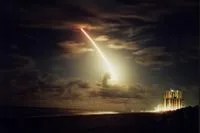3 min read
Cassini Mission to Saturn Celebrates 10 Years Since Launch
October 11, 2007
(Source: Jet Propulsion Laboratory)
 |
This picture of the Cassini launch was taken by Ken Sturgill of Marion, Virginia, using a 30 second, f 1.8, exposure on 400 speed film. |
Celebrating the 10th anniversary of its launch from Cape Canaveral, the Cassini-Huygens mission to Saturn is once again at the center of scientific attention. Its latest discoveries about the ringed planet are a leading topic of conversation among the nearly 1,500 scientists gathered this week at a major astronomy conference in Orlando, Fla.
Cassini rode into space Oct. 15, 1997, atop a U.S. Air Force Titan IVB. Its mission: to orbit and study the Saturnian system for four years and to put the European Space Agency's Huygens Probe in position to parachute down to the frozen surface of Saturn's Earthlike moon Titan. Since entering orbit around Saturn, Cassini's scientific instruments, powered by radioisotope thermoelectric generators, have returned immense amounts of new information via NASA's global Deep Space Network to the international team of scientists working on the mission.
Scientists aren't the only ones to benefit from Cassini's voyage of discovery. Since arriving at Saturn three-and-a-half years ago, Cassini's revelations have captured the public imagination. Its spectacular views of Saturn and its realm have graced the covers of magazines around the world. Millions have followed the mission's progress at NASA's web sites http://www.nasa.gov/cassini and http://saturn.jpl.nasa.gov .
At a Glance |
+ Video of launch + Launch summary |
"With Cassini, amazing discoveries have almost become routine," says Cassini project scientist Dennis Matson of NASA's Jet Propulsion Laboratory, Pasadena, Calif., where the international mission is managed.
"Orbiting Saturn, Cassini is in the middle of the greatest natural laboratory accessible to us in space," says Matson. "With its rings, dozens of moons and magnetic environment, Saturn is like a mini-solar system, with Saturn as a stand-in for the sun, and the moons and rings like planets in formation. Through Cassini and its instruments, we are making fundamental strides in understanding the physical processes that created and govern this and other solar systems."
Some of the discoveries include ice geysers shooting from Saturn's moon Enceladus and the finding that one of Saturn's rings is created from these ice particles. Recently, scientists found that material from Enceladus is also affecting the rotation of Saturn's magnetic field. And an onboard radar instrument, which sees through clouds, has been unveiling the fascinating world of Titan, the large moon with complex chemistry and lakes of hydrocarbons.
More information about the Cassini mission is available at http://www.nasa.gov/cassini and http://saturn.jpl.nasa.gov .
The Cassini-Huygens mission is a cooperative project of NASA, the European Space Agency and the Italian Space Agency. JPL, a division of the California Institute of Technology in Pasadena, manages the Cassini-Huygens mission for NASA's Science Mission Directorate, Washington. The Cassini orbiter was designed, developed and assembled at JPL.
Contacts:
Carolina Martinez 818-354-9382
Jet Propulsion Laboratory, Pasadena, Calif.
NEWS RELEASE: 2007-118







